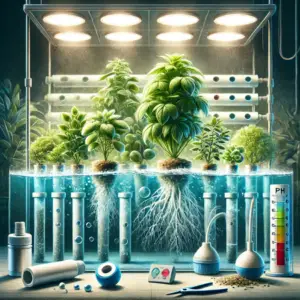Hydroponics, the method of growing plants without soil using nutrient-rich water solutions, is known for its efficiency and control over plant growth conditions. One common concern among hydroponic gardeners is whether plants can be overwatered in a hydroponic system. While hydroponics inherently involves a lot of water, it is possible to overwater plants if the system is not managed correctly. In this comprehensive guide, we will explore the concept of overwatering in hydroponics, its causes, symptoms, and how to prevent it to ensure healthy and thriving plants.

Understanding Overwatering in Hydroponics
Overwatering in hydroponics occurs when the plant roots are submerged in water for too long without adequate oxygen. Unlike soil-based systems, where overwatering typically results from excessive water retention in the soil, hydroponic systems rely on a careful balance of water and oxygen to support plant health.
Key Differences Between Soil and Hydroponic Overwatering
-
Soil Systems: Overwatering in soil systems leads to waterlogged soil, reducing oxygen availability to roots and promoting root rot.
-
Hydroponic Systems: Overwatering in hydroponics occurs when the roots are deprived of oxygen due to prolonged submersion or inadequate aeration, leading to root suffocation and poor plant health.
Causes of Overwatering in Hydroponics
Inadequate Oxygenation
In hydroponic systems, roots need access to both water and oxygen. If the water is not adequately oxygenated, or if the roots are submerged for too long without aeration, the plants can suffer from oxygen deprivation.
Continuous Flooding
In systems like Deep Water Culture (DWC) or Flood and Drain (Ebb and Flow), continuous flooding without proper drainage can lead to overwatering. Roots need periods of exposure to air to absorb oxygen effectively.
Poor Drainage
Improperly designed or maintained hydroponic systems that do not allow for adequate drainage can cause water to accumulate around the roots, leading to overwatering and root rot.
Lack of Air Stones or Pumps
Air stones and pumps are essential in hydroponic systems to provide oxygen to the water. Without these devices, the water can become stagnant, and oxygen levels can drop, causing overwatering issues.
Symptoms of Overwatering in Hydroponics
Identifying the symptoms of overwatering early can help you take corrective action before significant damage occurs. Common signs of overwatering in hydroponic plants include:
Yellowing Leaves
Yellowing of the leaves, particularly the lower leaves, is a common symptom of overwatering. This occurs because the roots are unable to absorb nutrients properly when oxygen levels are insufficient.
Wilting
Despite being surrounded by water, overwatered plants can wilt because their roots are suffocated and cannot transport water and nutrients effectively to the rest of the plant.
Root Rot
Brown, mushy, and foul-smelling roots are a clear sign of root rot, which results from prolonged exposure to water without adequate oxygen. Healthy roots should be white or light tan and firm to the touch.
Stunted Growth
Plants suffering from overwatering may exhibit stunted growth, as their roots are unable to support the uptake of essential nutrients and water needed for growth.
Fungal Growth
Excess moisture around the roots can promote the growth of harmful fungi and bacteria, leading to further root damage and plant health issues.
Preventing Overwatering in Hydroponics
Preventing overwatering in hydroponics involves ensuring proper oxygenation, drainage, and system maintenance. Here are some best practices to follow:
Use Air Stones and Pumps
Air stones and pumps are essential for maintaining adequate oxygen levels in the nutrient solution. They help keep the water aerated and provide a continuous supply of oxygen to the roots.
Implement Proper Flood and Drain Cycles
For systems like Ebb and Flow, ensure that the flooding cycles allow for proper drainage and air exposure. Roots should have sufficient time between flood cycles to access oxygen.
Monitor Water Levels
Regularly check and maintain appropriate water levels in your hydroponic system. Avoid allowing the water to rise too high, which can submerge the roots and reduce oxygen availability.
Maintain Clean Systems
Regularly clean and maintain your hydroponic system to prevent blockages and ensure proper drainage. This helps prevent water from accumulating around the roots.
Use Well-Designed Growing Media
Choose growing media that provide good aeration and drainage, such as clay pebbles, perlite, or rockwool. These materials help support root health by allowing air to reach the roots.
Regularly Inspect Plant Health
Regularly inspect your plants for signs of overwatering, such as yellowing leaves, wilting, and root rot. Early detection allows for prompt corrective action to prevent further damage.
Recommended Products for Hydroponic Systems
Investing in high-quality products for your hydroponic system can help prevent overwatering and ensure optimal plant health. Here are some top recommendations:
-
NuAqua Systems
NuAqua Systems offers advanced reverse osmosis systems that ensure clean and balanced water for your hydroponic plants. Their systems are designed to remove contaminants and provide pure water, crucial for maintaining optimal plant health. Discover NuAqua Systems for reliable water filtration solutions. -
Lettuce Grow Farmstand
The Lettuce Grow Farmstand is an excellent self-watering and self-fertilizing vertical garden system. It is perfect for both indoor and outdoor use and allows you to grow a variety of crops effortlessly. Using filtered water with the Farmstand can significantly improve plant health and yield. Shop the Farmstand to find the perfect size for your needs. -
Growace Complete Home Kit
This comprehensive grow kit from Growace includes everything you need for a successful indoor hydroponic setup. It features high-quality grow lights, a tent, a ventilation system, and all necessary accessories. Using filtered water with this system can enhance performance and plant growth. Check out the complete kit to start growing your plants indoors efficiently.
Conclusion
While hydroponic systems are designed to provide plants with constant access to water, it is possible to overwater plants if the system is not managed correctly. Overwatering in hydroponics occurs when the roots are deprived of oxygen due to prolonged submersion or inadequate aeration. By understanding the causes and symptoms of overwatering and implementing best practices for oxygenation, drainage, and system maintenance, you can ensure healthy and thriving plants in your hydroponic garden.
Regularly monitoring plant health, using high-quality aeration equipment, and maintaining a clean and well-designed system are essential steps to prevent overwatering. By following these guidelines, you can optimize your hydroponic setup and enjoy the benefits of efficient and productive plant growth.
For more tips, products, and community support, visit Vertical Farming Planet. Join us in our mission to promote sustainable living and innovative gardening techniques.
